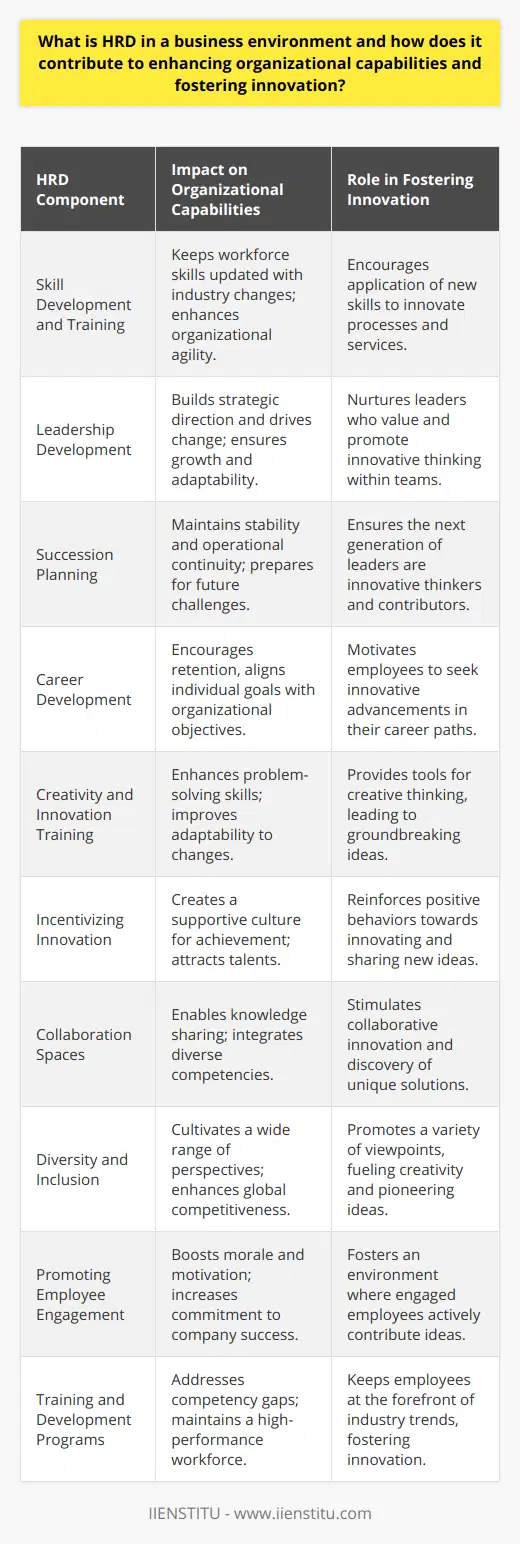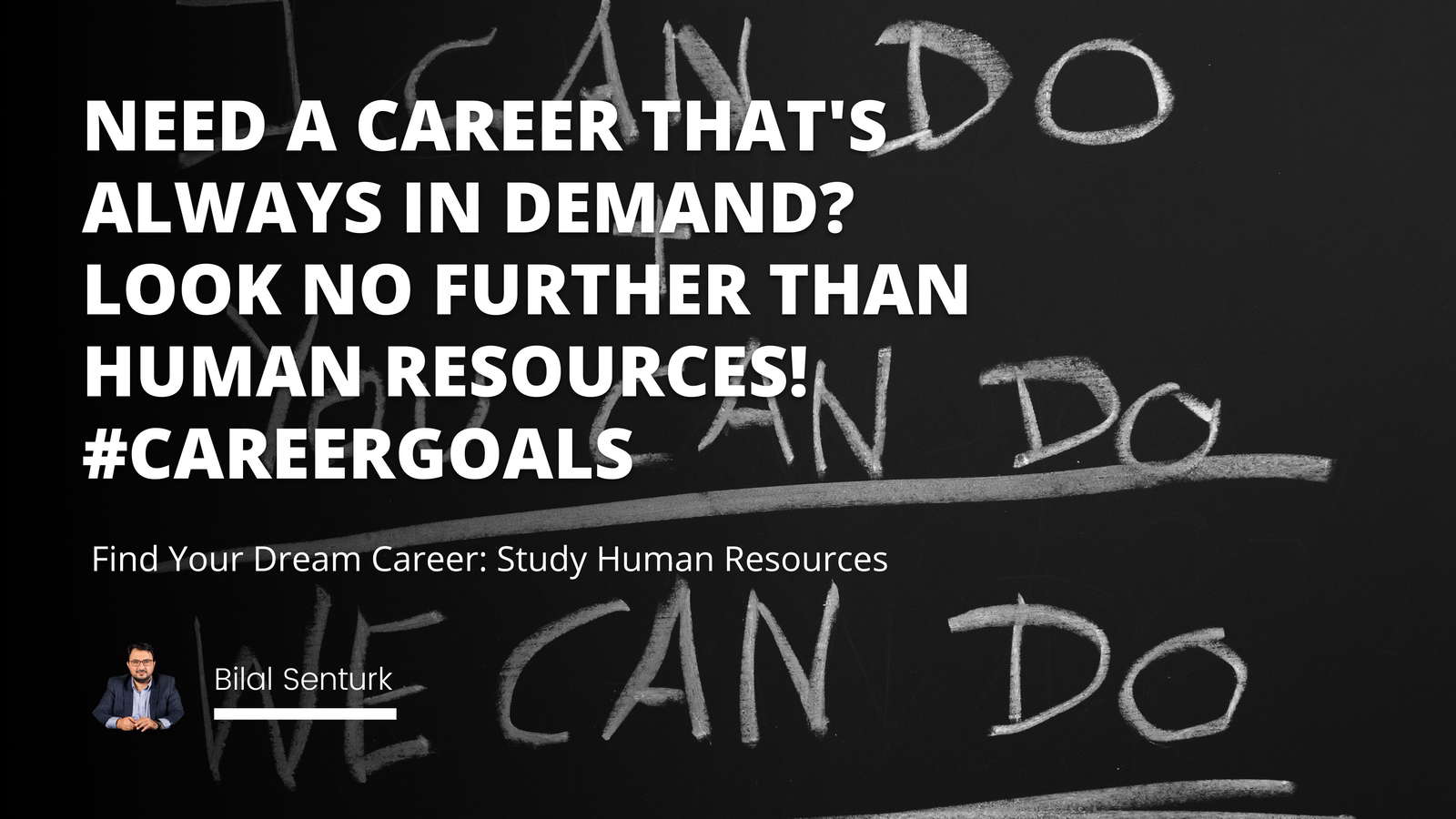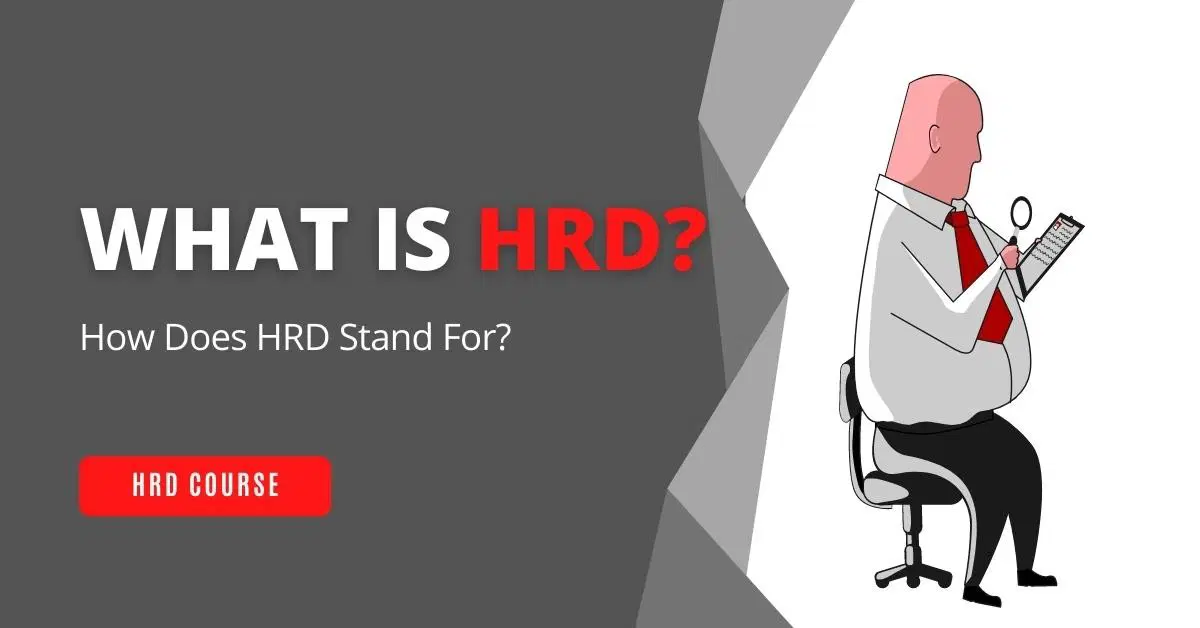
Businesses grow over time, and with that comes the need to hire additional human resources. Because human resources are part of a company's identity. They must have developed plans to benefit all employees within their workforce. HRD stands for Human Resources Development, defined as an organizational process for improving employee performance. This can be done through training, skill-building, leadership development programs, etc., all geared towards enhancing organizational goals while simultaneously developing individual skills.
Related Course: Leadership Course Online
HRD can be broken down into three areas:
1) Learning Organizations - organizations where there are opportunities for learning at every level of the organization, including informal learning techniques
2) Communicating Organisations - organizations that ensure effective communication between members through dialogue, feedback, etc
3) Developing Organisations - organizations that are conscious of human potential and enabling their human resources to grow in work-related areas
What is HRD?
Human Resources Development (HRD) is the process of developing and improving individuals so that their performance achieves an organization's goals, allowing them to meet organizational objectives and maximize their productivity.
Human Resources Development is an organization's ability to improve the skill sets of its employees for them to perform better at their jobs. Therefore, Human Resources Development is also an organizational process for improving employee performance through training, skill-building, leadership development programs, etc. These are geared towards enhancing organizational goals while simultaneously developing individual skills.
How Does HRD Stand For?
The human resources department is an essential part of any company. HRD stands for human resources development. It means that the human resources department trains its employees to improve their skills and become more beneficial.
Human resource development (also known as human resources management) is managing human resources or people within an organization. It includes all functions related to the growth and performance of human capital in organizations. HRD stands for human resource development. Human resources development does not necessarily mean training; it may include other activities that help people develop their potentials further. For this reason, human resource development is also known as human resources management. HRD follows closely with human remuneration because remuneration means remunerating someone's effort with rewards according to their contribution to their company or team.
HRD stands for human resource development and means that the human resources department develops human resources such as employees to improve their skills and become valuable company members.
However, human resource development is not only training; it also includes other activities that help people develop their potentials further:
1) Training: Employees must be trained to become valuable members of the company. According to Google dictionary, the first example of human resource development shows something quite clear: "Staff training initiatives…". Everyone at work should know how to do what they are paid to do. Therefore, human resource development means that the human resources department provides them with the necessary skills.
2) Participation: What is human resource development without any rights of human resources? For human resources to become valuable members of a company, they should be involved in decision-making processes that concern them directly. The more human resource contributes to how they want their workplace to look like, the better work environment will result. Consequently, more value will contribute to the company.
3) Cooperation: Cooperating is always better than competing; this is what human resource development tries to teach their team members as well. Therefore human resources such as employees should cooperate to produce good results for the company that employs them. Again, this is human resource development.
4) Continuing education: Human resources such as employees in the human resources department must be taught how valuable learning can be in life and how it will affect their future. Unfortunately, many people learn only at school and university. Still, human resource development shows that we should continue learning even after we graduate from both schools. This is human resources development (HRD).
5) Quality of work: Funnily enough, this falls under human resources management instead of human resources development, but its influence on human resources makes it worthy for HRD inclusion. All human resources must ensure good quality; they cannot produce something wrong or inferior to what they were hired to do and still expect a promotion in their job. If they do low-quality work, human resources development means they should be coached to change their low quality into a higher one. For example, systemic coaching is the best way to coach employees.
6) Flexibility: This factor is significant; human resources such as employees must know how to change and become flexible to adapt at times when changes occur. For example, the human resources department may close one of its departments (division). The human resources need to support other human resource activities that concern them directly or indirectly. This is human resource development (HRD).
7) Teamwork: The human resources department should also teach human resources, such as employees, how essential teamwork is for the work process. Whether one works in human resources or human resource development, one must act like a team player and contribute to the overall success of the human resources department/team. Cooperation with other human resources is human resource development.
8) Ethical behavior: This factor is about doing ethical actions towards every single member of the company each employee gets involved with. The human resources department should create an example of perfectly ethical behavior to encourage human resources to follow it. This is human resource development (HRD).
9) Business knowledge: It is surprising to see how many think that business knowledge is not part of HRD. But suppose they consider the term human resources management. In that case, they will realize that human resource management means managing or influencing every aspect of an organization, including its core business. This means that all humans who work within a company must have at least some basic understanding of what it takes for their company to survive in the market and generate profit at the end of each fiscal year. Every employee contributes to their company's success with every action they take towards it; this is human resource development (HRD).
Related Course: Hr Certificate Course
Does human resource development refer to anything other than HRD?
HRD is not the only work done in human resources development. It involves various jobs and careers, which all hold human resources development as their primary focus. This can include human resources management, human resources consulting, human resources officer, human resources director, human resources assistant, and many more.
Does human resource development involve everyone working in this field?
No, it does not. Human resource development is such a broad term that it involves employees from multiple industries and professions; therefore, every employee cannot be included in human resource development.
How To Learn HRD?
If you want to work HRD field and want to learn more about human resources, you can join HRD courses. For example, IIENSTITU has Human Resources Development Course. This course is a video course, and you can join this course and get a certificate of achievement to use in your work life. So you can join today and begin to learn quickly!
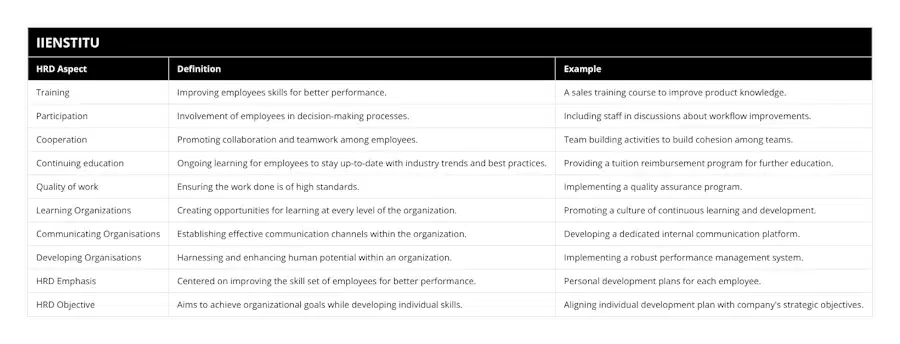
Frequently Asked Questions
Does human resource development refer to anything other than HRD?
HRD is not the only work done in human resources development. It involves various jobs and careers, which all hold human resources development as their primary focus. This can include human resources management, human resources consulting, human resources officer, human resources director, and many more.
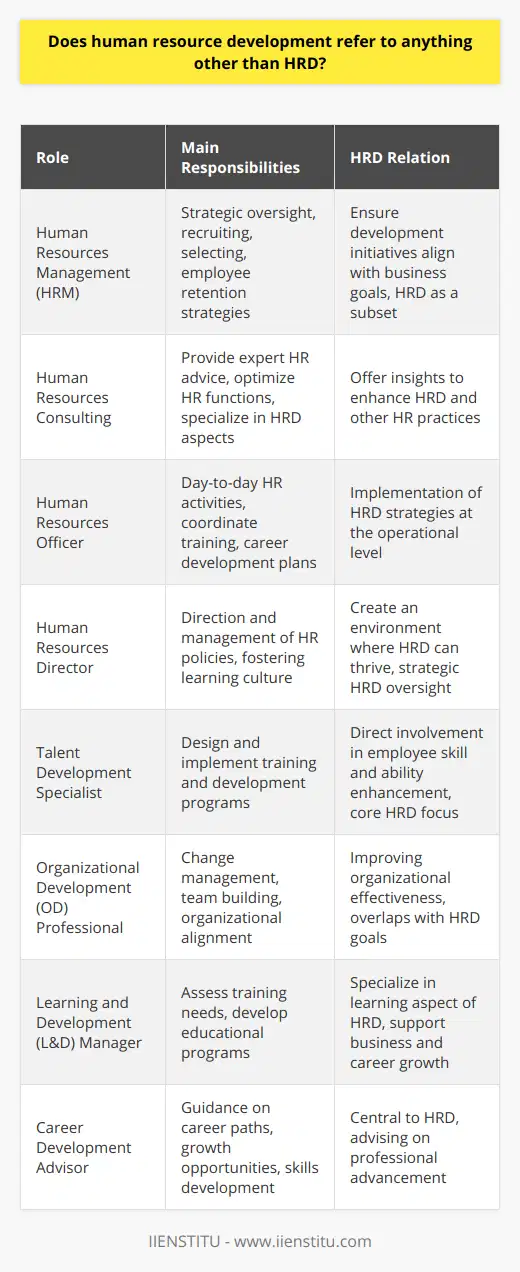
Does Human Resource Development involve everyone working in this field?
No, it does not. Human resource development is such a broad term that it involves employees from multiple industries and professions; therefore, every employee cannot be included in human resource development.
How To Learn HRD?
If you want to work HRD field and want to learn more about human resources, you can join HRD courses. For example, IIENSTITU has Human Resources Development Course. This course is a video course and you can join this course and get a certificate of achievement to use in your work life. So you can join today and begin to learn quickly!
What types of activities are included in Human Resource Development?
Human Resource Development activities typically include training and development, career planning, performance management, coaching and mentoring, succession planning, and organizational development.

How can HRD help an organization improve its performance?
HRD (Human Resource Development) can help an organization improve its performance by focusing on the development of its workforce. This can include providing employees with the necessary training and resources they need to succeed, as well as providing a positive working environment that encourages employees to reach their full potential. HRD can also help implement processes and procedures to ensure that the organization is running optimally and in line with its goals. This can include performance management, recruitment, and employee engagement initiatives.
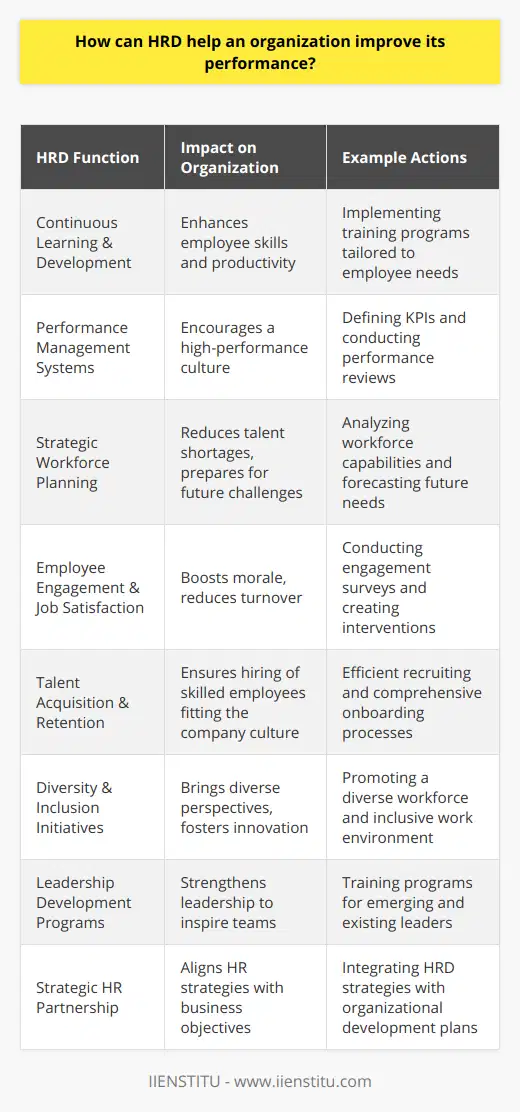
What are the benefits of having an effective Human Resource Development program?
Increased employee engagement and performance: An effective HRD program can help increase employee engagement and performance by providing employees with opportunities for growth and development. This can help them become more motivated to succeed and be productive in their work.
Improved employee retention: An effective HRD program can help retain top talent by providing employees with the necessary training and development they need to stay current with the changing workplace. This can help reduce turnover and save the company money in the long run.
Improved recruitment and selection processes: An effective HRD program can also help streamline recruitment and selection processes by providing access to the right tools and resources to help identify the best candidates for a position. This can help the company save time and money while finding the right people for the job.
Increased job satisfaction: An effective HRD program can help increase employee job satisfaction by providing them with the support and resources they need to succeed. This can lead to greater job satisfaction and a more enjoyable work experience.
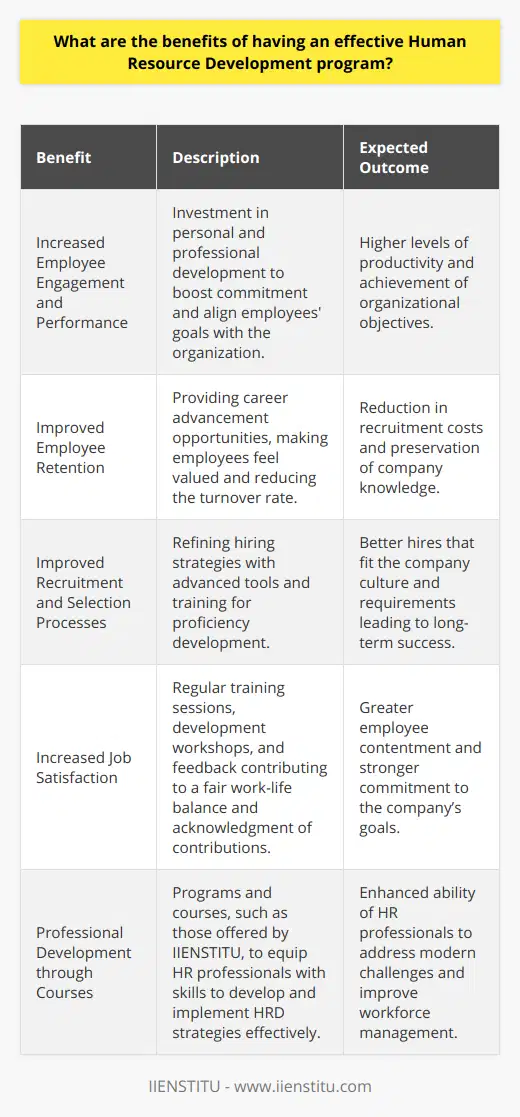
What is the significance of HRD in employee development and organizational growth?
Significance of HRD in Employee Development
Human Resource Development (HRD) plays a crucial role in fostering employee development, ultimately leading to organizational growth. It encompasses various activities and interventions designed to improve individual and organizational capabilities, as well as cultivate the necessary skills and competencies in the workforce. Such activities promote increased productivity, employee engagement, and seamless adaptation to changing business environments.
Enhancing Employee Skillset
One significant aspect of HRD in employee development is the provision of training and development opportunities. These initiatives enhance the knowledge, skills, and abilities of employees, enabling them to perform their tasks efficiently and with greater effectiveness. Additionally, continuous learning and professional development stimulate career growth, contributing positively to employees' job satisfaction and motivation.
Nurturing Leadership and Management Capabilities
HRD also plays a pivotal role in identifying and cultivating leadership skills within the organization. By offering targeted programs and mentoring, HRD helps employees develop essential management and leadership capabilities. This not only prepares them for higher roles but also ensures a robust talent pipeline for the organization, driving its long-term sustainability and success.
Promoting Organizational Culture
A strong organizational culture is essential for creating a conducive work environment that fosters employee motivation, loyalty, and commitment. HRD plays an instrumental role in developing a positive work culture by implementing effective communication practices, conflict resolution strategies, and team-building initiatives. These efforts facilitate collaboration and camaraderie among employees and drive employee retention.
Fostering Employee Engagement
Employee engagement is a critical driver of organizational performance, and HRD contributes significantly to ensuring high levels of engagement. Through regular performance appraisals, feedback mechanisms, and recognition programs, HRD reinforces desired behaviors and motivates employees to excel in their jobs. Additionally, HRD policies aimed at employee wellbeing and work-life balance also enhance employee satisfaction and commitment to the organization.
In conclusion, HRD serves as an indispensable function that fosters employee development, leading to increased productivity, innovation, and overall organizational growth. By focusing on skill enhancement, leadership development, organizational culture, and employee engagement, HRD ensures the continuous adaptability and resilience of the organization in a rapidly evolving business landscape.
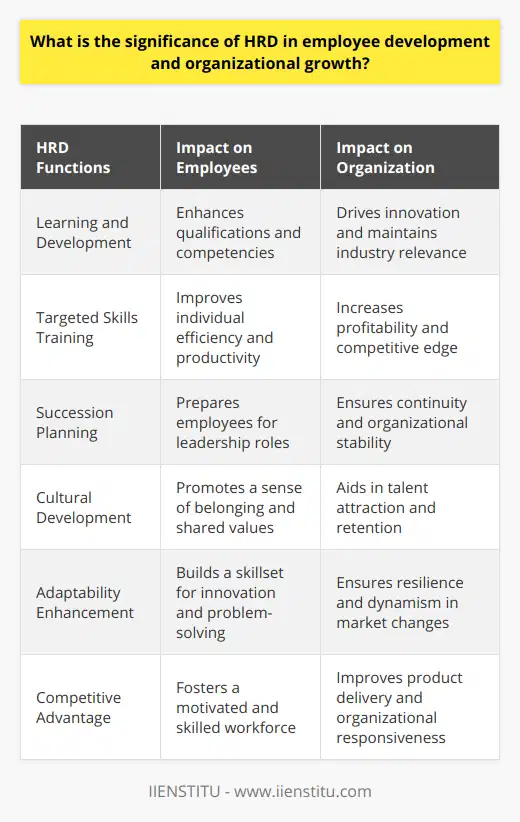
How do HRD practices contribute to enhancing cultural diversity and inclusivity in the workforce?
**Cultural Diversity and Inclusivity Enhancement**
HRD practices play a significant role in fostering cultural diversity and inclusivity within organizations. By implementing training programs, policies, and strategies that emphasize valuing diverse perspectives, companies can build a workforce that thrives on differences and embraces change. In turn, this leads to increased creativity, innovation, and overall performance.
**Training Programs**
A key aspect of promoting cultural diversity and inclusivity is offering training programs for employees. These programs typically address topics such as unconscious bias, microaggressions, and cultural sensitivity. By becoming aware of personal biases and actively seeking to change them, employees can contribute to a more inclusive and respectful work environment.
**Diversity Policies and Strategies**
Organizations should also create and implement policies that support diversity and inclusivity. These policies may include fair hiring practices, equal employment opportunities, and non-discrimination clauses. To ensure success, companies should continuously monitor and evaluate the effectiveness of these policies, making adjustments as necessary.
**Mentoring and Networking Opportunities**
Providing mentoring and networking opportunities for underrepresented groups can also promote cultural diversity and inclusivity. These initiatives help employees gain access to essential resources and connections, fostering a sense of belonging and empowerment. By supporting the professional growth of diverse employees, organizations can facilitate increased contributions and potentially reduce turnover.
**Conflict Management**
Addressing conflicts that arise from cultural differences is crucial for maintaining a diverse and inclusive workforce. HRD practices such as conflict management training and mediation services can help employees navigate these situations in a constructive manner. Moreover, organizations can establish clear procedures for reporting and resolving disputes to ensure a fair and transparent process.
**Leadership Commitment**
Lastly, in order for HRD practices to successfully foster cultural diversity and inclusivity, they must be supported by organizational leadership. Leaders should model inclusive behavior, actively engage in training programs, and allocate resources towards diversity initiatives. This commitment serves as a strong foundation for cultivating a diverse and inclusive company culture.
In conclusion, HRD practices contribute significantly to enhancing cultural diversity and inclusivity in the workforce. By offering training and mentoring opportunities, implementing supportive policies and strategies, managing conflicts effectively, and securing robust leadership commitment, organizations can create dynamic and high-performing teams that value and celebrate their differences.
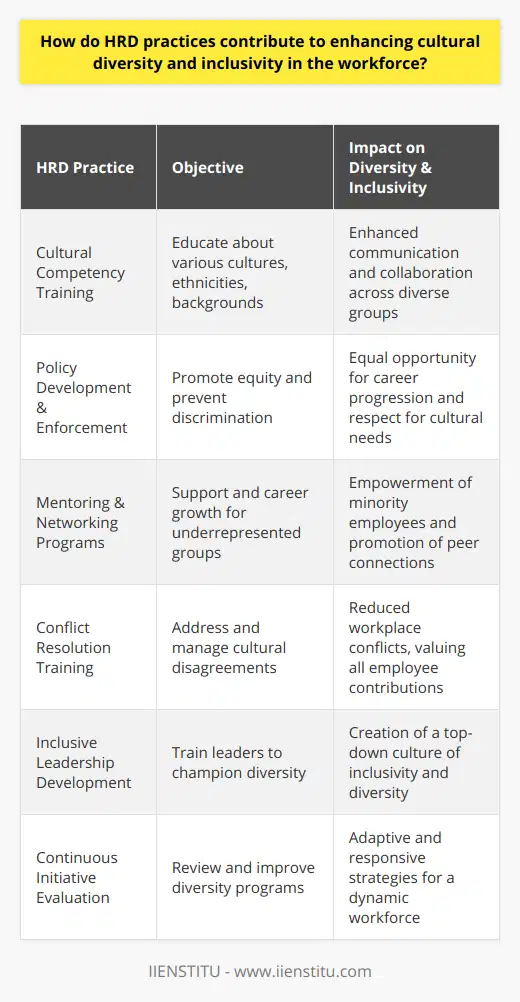
What are the key components of strategic HRD and how do they align with overall business goals?
Key Components of Strategic HRD
Strategic Human Resource Development (HRD) is an essential element of modern organizational management, focusing on enhancing the skills, knowledge, and capabilities of employees to optimize business performance. The key components of strategic HRD include competency development, performance management, and organizational development. These components are designed to align with overall business goals and drive success through employee growth and development.
Competency Development
Competency development is a process of identifying the necessary skills, knowledge, and abilities required for employees to perform their roles effectively. This process entails assessing current competencies, identifying gaps, and developing targeted training programs to close these gaps. By aligning competency development with business goals, organizations can ensure a skilled and capable workforce that contributes to successful outcomes.
Performance Management
Effective performance management is critical for aligning employee efforts with organizational objectives. It involves establishing clear performance expectations, measuring employee progress, providing feedback, and taking corrective actions when necessary. Strategic HRD ensures that performance management aligns with overall business goals by continuously evaluating employee performance against predefined targets and enabling adjustments to support business needs.
Organizational Development
Lastly, organizational development focuses on creating a positive work environment that fosters employee growth, motivation, and engagement. This involves building a strong organizational culture, promoting effective communication, and implementing change management strategies. By cultivating a supportive environment, strategic HRD enables organizations to achieve business goals through the enhanced productivity and satisfaction of their workforce.
In conclusion, strategic HRD encompasses key components such as competency development, performance management, and organizational development to optimize employee performance and ensure alignment with business goals. By integrating these elements, organizations can create a capable and motivated workforce that contributes to achieving successful outcomes and maintaining a competitive advantage in the marketplace.
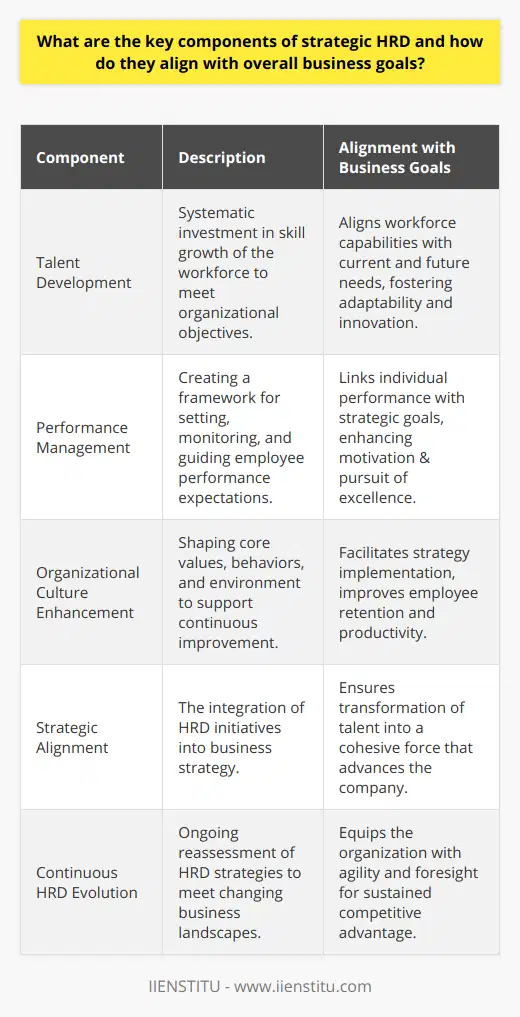
What do you mean by HRD and how does it impact an organization's growth and success?
Understanding HRD
Human Resource Development (HRD) refers to the systematic process of enhancing the knowledge, skills, and capabilities of an organization's workforce in order to achieve its strategic objectives. The main purpose of HRD is to optimize human capital by fostering a continuous learning culture within the organization, which encompasses various activities such as employee training, talent management, and organizational development.
Impact on Organizational Growth
The impact of HRD on an organization's growth and success cannot be overstated. By investing in employee development, organizations can improve their overall performance and productivity. In addition, a well-designed HRD program contributes to employee engagement and job satisfaction, which in turn reduces staff turnover and associated costs. Moreover, HRD initiatives help create a pool of skilled and knowledgeable employees who can innovate and adapt to evolving market demands, thereby providing a competitive edge to the organization.
Role of Training and Development
Training and development activities are critical components of HRD that aim to upgrade employees' skills, knowledge, and abilities. By offering regular and targeted training opportunities, organizations empower their employees to effectively perform their job responsibilities and contribute to the achievement of organizational goals. Furthermore, advanced training programs can help identify and develop high-potential employees, nurturing future leaders who can drive organizational success in the long term.
Talent Management Strategies
Implementing effective talent management strategies is another crucial aspect of HRD. Talent management processes include assessing and identifying an organization's talent requirements, recruiting suitable candidates, developing career progression plans, and retaining high-performing employees. By aligning HRD initiatives with an organization's strategic objectives, HR professionals can ensure that the workforce is well-equipped to navigate challenges, capitalize on opportunities, and sustain growth.
Organizational Development Initiatives
Successful HRD programs also encompass organizational development initiatives that help create a conducive work environment and foster employee growth. This includes establishing effective communication channels, encouraging cross-functional collaboration, and creating opportunities for knowledge sharing. By fostering an organizational climate that values learning and continuous improvement, organizations can better adapt to changes, maintain a competitive edge, and achieve sustainable growth.
In conclusion, HRD plays a pivotal role in promoting an organization's growth and success by nurturing a skilled, knowledgeable, and motivated workforce. Through comprehensive training programs, talent management strategies, and organizational development initiatives, organizations can leverage HRD to optimize human capital, enhance employee engagement, and achieve their strategic objectives.
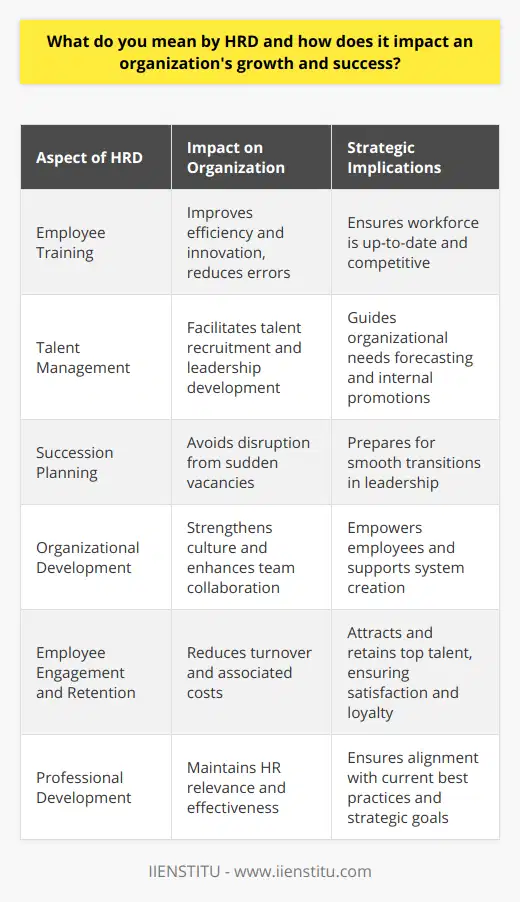
How is HRD different from HRM, and what unique roles do they each play in workforce development?
Distinct Approaches: HRD and HRM
Human Resource Development (HRD) and Human Resource Management (HRM) are distinct yet complementary approaches to workforce development. HRD primarily focuses on employee development, learning, and training opportunities to enhance their skills and competencies, fostering a continuous learning environment. HRM, on the other hand, is a broader organizational function encompassing recruitment, compensation, performance management, and employee relations.
Employee Development in HRD
A prime objective of HRD is developing the capabilities of individual workers to maximize their performance and contribution to the organization. This is achieved through targeted training programs, workshops, and other educational initiatives aimed at honing specific skills or addressing knowledge gaps. By investing in employee development, HRD increases an organization's competitive advantage, improves employee retention, and ensures a skilled and adaptive workforce.
Comprehensive HRM Functions
HRM encompasses a range of workforce management activities that extend beyond employee development. These activities include talent acquisition, which involves attracting and selecting the right candidates for organizational roles; performance management, which entails setting performance expectations and providing ongoing feedback; and compensation and benefits administration, which includes developing and managing pay structures and employee benefits programs. Furthermore, HRM also deals with employee relations, fostering positive working relationships, and ensuring adherence to labor laws and legislation.
Integration for Effective Workforce Development
Both HRD and HRM play vital roles in workforce development. While HRD focuses on enhancing employee skills and capabilities, HRM is responsible for creating the infrastructure and processes that support, evaluate, and reward these efforts. Thus, an effective workforce development strategy requires integrating HRD initiatives with broader HRM functions. By combining targeted employee development initiatives with comprehensive HRM policies, organizations can develop an agile, high-performing workforce equipped to adapt rapidly to changing business needs and environment.
In conclusion, HRD and HRM function as complementary approaches to workforce development, catering to the unique requirements of employee skills enhancement and overall organizational performance. A robust and effective human resource strategy incorporates both HRD and HRM functions, ensuring a skilled and adaptable workforce is in place to drive growth and success.

In the context of education and professional development, what does HRD stand for and how does it relate to leadership and management roles within an organization?
Understanding HRD
In the context of education and professional development, HRD stands for Human Resource Development. It encapsulates various processes designed to develop individuals within an organization. HRD primarily focuses on enhancing employees' skills and fostering a culture of continuous learning and improvement. This concept is crucial for organizations to remain dynamic, adaptable, and competitive.
HRD and Leadership
HRD plays a significant role in leadership development as it helps identify potential leaders and molds them to fill crucial positions within the organization. Through targeted training programs, mentoring, and succession planning, HRD allows individuals to acquire essential leadership qualities, such as effective communication, decision-making, and strategic thinking. Ultimately, HRD strengthens organizational leadership, ensuring long-term success and stability.
HRD and Management Roles
In the realm of management, HRD is relevant for numerous reasons. First, HRD assists in developing managerial skills in topics such as teamwork, conflict resolution, and critical thinking. Second, HRD allows organizations to create a talent pool of capable individuals, facilitating workforce planning and reducing the reliance on external hires for key positions. Furthermore, HRD plays a vital role in motivating and retaining employees by focusing on their learning, advancement goals, and overall satisfaction.
In essence, HRD aligns closely with leadership and management roles as it enables organizations to effectively identify, develop, and empower their workforce. By investing in HRD initiatives, organizations can create a knowledgeable, skilled, and motivated team that is ready to take on current and future challenges. A strategic focus on HRD is vital for nurturing leaders, developing high-performing managers, and ensuring organizational success.
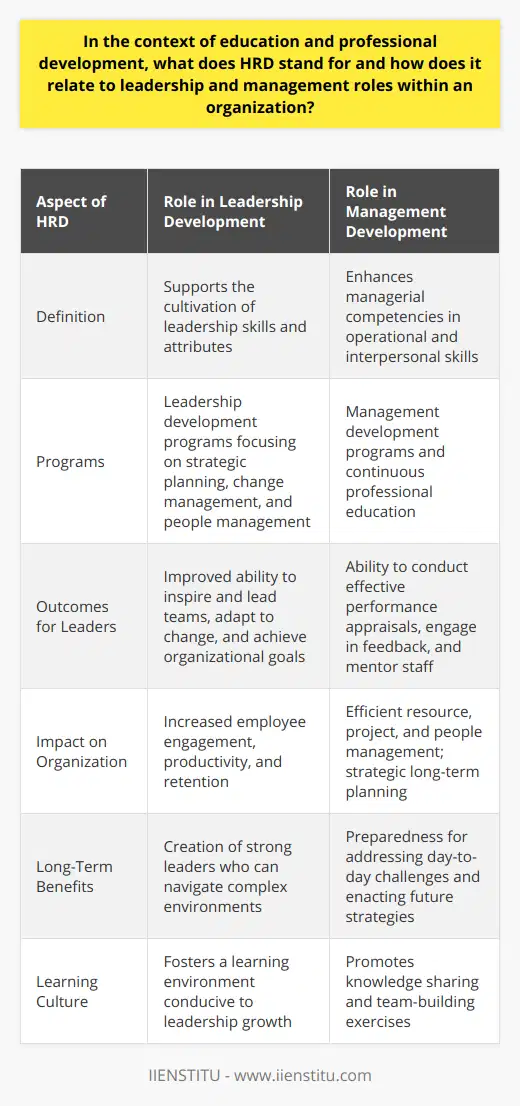
What do you mean by HRD in the context of organizational performance and sustained growth?
Defining HRD in Organizational Performance
Human Resource Development (HRD) is essential in the realm of organizational performance and sustained growth. HRD refers to the strategic initiatives and actions focused on enhancing the competencies, knowledge, and skills of an organization's workforce. This discipline is anchored in the belief that human capital is a critical driver of sustainable competitive advantage.
Role of HRD in Performance Enhancement
Effective HRD programs ensure that the workforce is qualified and proficient in addressing the evolving business requirements. This includes training, coaching, and mentoring to empower employees not only to adapt to change but also to innovate and contribute to an organization's strategic objectives. By investing in the continuous development of employees, companies can significantly boost their productivity, efficiency, and overall performance.
Influence of HRD on Employee Retention
Fostering an environment of learning and development is essential in attracting, motivating, and retaining top talent. HRD initiatives, such as career progression opportunities and targeted training programs, enable employees to advance their career goals within the organization. This contributes to higher levels of job satisfaction and a reduced likelihood of turnover, which directly impacts an organization’s bottom line.
HRD and Organizational Culture
Beyond business performance, HRD shapes the ethos and culture of an organization. A learning-oriented culture encourages employees to take ownership of their professional growth and think creatively about problem-solving. Employees that feel supported in their development become more engaged, leading to stronger collaboration and a shared vision for the organization's success.
Sustained Growth and HRD Integration
For an organization to attain long-term growth, HRD strategies must align with overall business goals. This includes implementing robust succession planning, diverse recruitment practices, and extensive onboarding programs to ensure that the workforce is equipped with the right skills, knowledge, and abilities. A well-rounded HRD approach with a keen focus on talent development drives innovation, prepares organizations for future challenges, and, in turn, secures sustained growth.
In conclusion, HRD plays a pivotal role in organizational performance and sustained growth. By nurturing employees' skills, competencies, and overall well-being, companies can foster an innovative, customer-focused, and competitive workforce that is critical to building and maintaining long-term success in today’s rapidly changing business landscape.
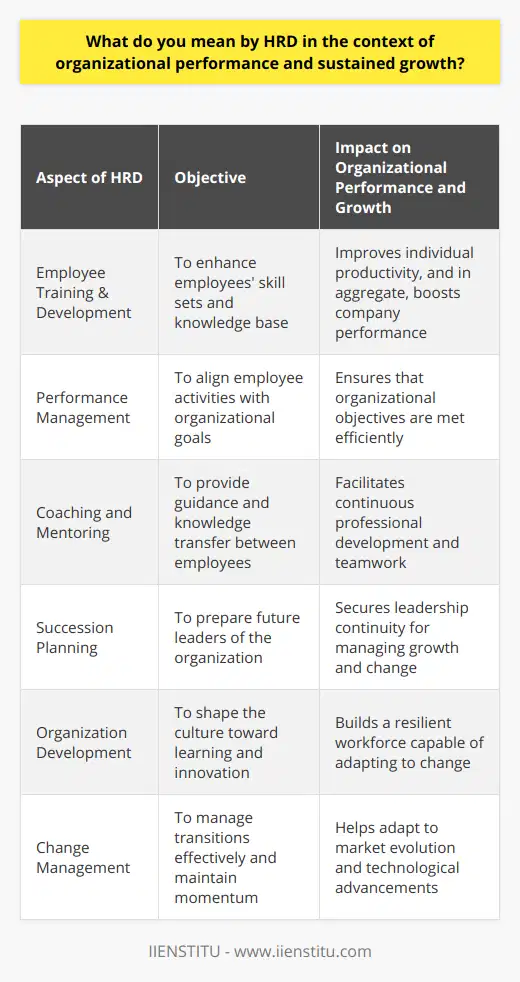
How does the implementation of HRD strategies promote effective leadership within an organization?
HRD Strategies and Leadership Development
The implementation of Human Resource Development (HRD) strategies plays a crucial role in promoting effective leadership within organizations. These strategies aim at enhancing the skills and competencies of the employees, including the leaders, to improve their performance and increase organizational effectiveness.
Employee Training and Development
One of the core components of HRD is employee training and development. By systematically designing and implementing training programs targeting potential leaders, organizations can ensure that they are equipped with the requisite knowledge, skills, and abilities to excel in leadership roles. This includes soft skills, such as communication, problem-solving, and decision-making, as well as hard skills relevant to their specific job functions.
Mentoring and Coaching
Another essential element of HRD strategies is mentoring and coaching. By pairing experienced leaders with high-potential employees, organizations facilitate knowledge sharing and skill development. Mentorship provides proteges with valuable insights and guidance, helping them navigate organizational complexities and develop leadership qualities. Besides, coaching programs further refine an individual's leadership style and offer personalized feedback for continuous improvement.
Succession Planning
A comprehensive HRD strategy involves succession planning, which ensures a continuous supply of competent leaders within an organization. By identifying and preparing high-potential employees for leadership roles, organizations can minimize disruption caused by turnover and secure a smooth leadership transition. This is vital for maintaining organizational stability and driving long-term success.
Performance Management and Feedback
Effective HRD strategies prioritize performance management and feedback mechanisms for leaders, enabling them to assess their strengths and weaknesses and develop targeted improvement plans. Frequent performance evaluations and constructive feedback promote self-awareness, learning, and growth, thereby fostering effective leadership.
Creating a Leadership Culture
Lastly, by implementing HRD strategies, organizations cultivate a learning culture that encourages the continuous development and improvement of leadership skills. This culture empowers employees to take responsibility for their development, seek feedback, and adapt to changing circumstances, resulting in resilient and resourceful leaders.
In conclusion, the implementation of HRD strategies significantly promotes effective leadership within organizations by focusing on employee training, mentoring, succession planning, performance management, and fostering a leadership culture. By investing in the development of their employees and leaders, organizations ensure organizational growth, sustainability, and success in the long run.
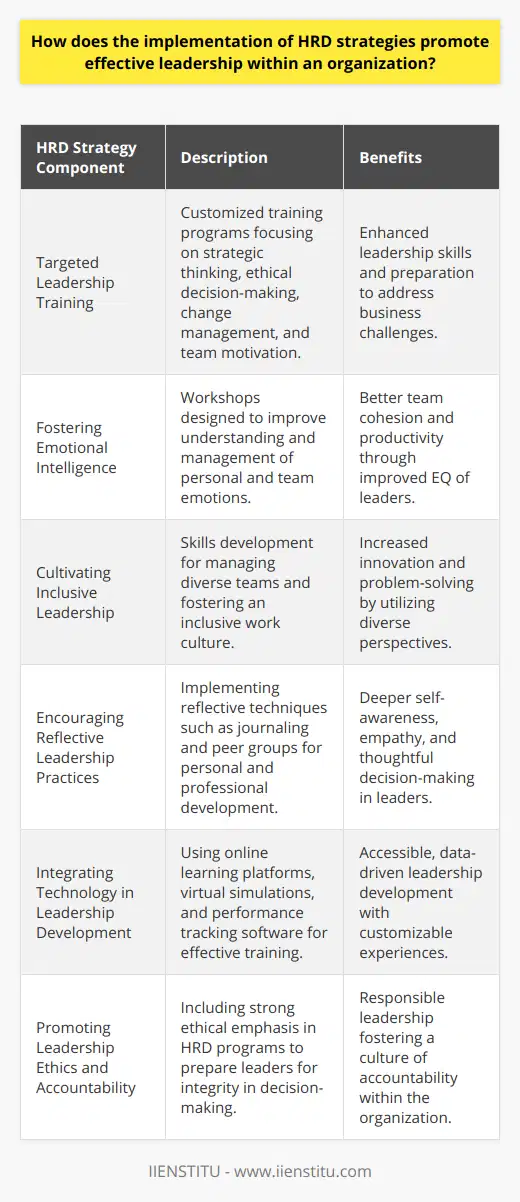
Can you explain the role of HRD in fostering a culture of continuous learning and professional development in educational institutions?
The Role of HRD in Promoting Continuous Learning
Human Resource Development (HRD) plays a significant role in fostering a culture of continuous learning and professional development in educational institutions. As a strategic partner, HRD takes the lead in designing and implementing learning initiatives that empower staff to stay updated with the latest trends in education and advance in their careers.
Needs Assessment and Customized Solutions
One of the key functions of HRD is to identify the learning needs of both individual employees and the institution as a whole. By conducting a thorough needs assessment, HRD can create customized training programs and resources that address specific skill gaps and empower educators to perform their job effectively.
Professional Development Opportunities
HRD offers various professional development opportunities to educators, such as workshops, seminars, and online courses. These programs facilitate continuous learning by staying abreast of the latest research, techniques, and best practices in the field of education. They also provide avenues for educators to gain new qualifications and enhance their expertise.
Mentoring and Coaching Support
HRD also plays a critical role in promoting a coaching and mentoring culture within educational institutions. By pairing experienced staff members with newer employees, HRD encourages knowledge sharing, collaboration, and mutual growth. This support system enables educators to develop their skills and competencies, leading to improved performance and job satisfaction.
Evaluation and Feedback Mechanisms
Another important function of HRD is to establish effective evaluation and feedback mechanisms, such as performance appraisals and peer reviews. These processes allow educators to track their progress, gain insights into their strengths and areas for improvement, and set goals for further development. Feedback from colleagues also fosters a growth mindset and drives continuous learning.
Creating a Learning Environment
Lastly, HRD contributes to fostering a culture of continuous learning by promoting a supportive learning environment within educational institutions. This includes creating and maintaining learning spaces, providing easy access to learning resources and technology, and encouraging collaboration and open communication among staff members.
In conclusion, HRD plays a vital role in fostering a culture of continuous learning and professional development in educational institutions. Through comprehensive needs assessment, custom training programs, professional development opportunities, mentoring and coaching, evaluation and feedback mechanisms, and the creation of supportive learning environments, HRD ensures that educators are well-equipped to excel in their roles and advance in their careers.
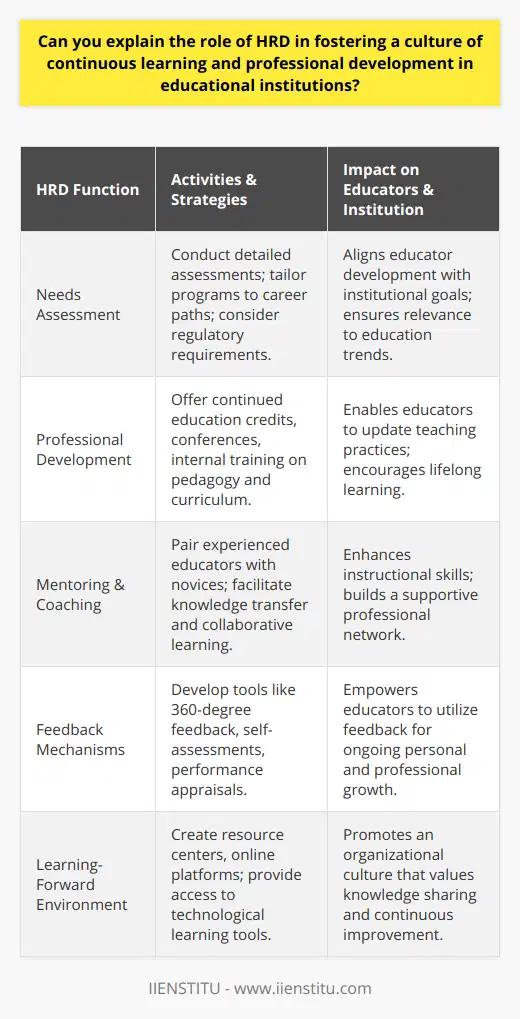
What do you mean by HRD and how does it impact an organization's growth and success?
Understanding HRD
Human Resource Development (HRD) refers to the systematic process of enhancing employees' skills, knowledge, and competencies to improve their performance and contribute positively to an organization's success. HRD initiatives include structured training programs, mentoring, and coaching, which develop individual abilities and support the overall growth and development of an organization.
Impact on Organizational Growth
Effective HRD programs have a direct impact on organizational growth by improving employee performance, retaining top talent, and fostering an optimal work culture. Continuous development opportunities help employees adapt to emerging challenges, promoting innovation and quick decision-making processes that drive a competitive edge in the marketplace.
Enhanced Employee Performance
A well-designed HRD program increases employees' knowledge and skillset, leading to improved individual and team performance. Equipped with better capabilities, employees can maximize their contributions, resulting in increased efficiency, productivity, and ultimately, profitability for the organization.
Talent Retention and Attraction
Organizations that prioritize HRD become more attractive to potential candidates and increase the likelihood of retaining valuable employees. A nurturing work environment with growth opportunities contributes to higher job satisfaction and employee engagement, reducing turnover rates and recruitment costs while sustaining a skilled workforce that can drive business success.
Positive Work Culture and Collaboration
Through effective HRD, organizations can foster a positive work culture that encourages learning, knowledge-sharing, and collaboration among employees. Continuous learning environments help promote teamwork by breaking down silos and encouraging cross-functional collaboration, leading to better decision-making and problem-solving capabilities that fuel the organization's growth and success.
In summary, HRD plays a crucial role in enhancing employees' capabilities, driving performance improvements, and creating a work culture that attracts, retains, and nurtures top talent. By investing in HRD programs, organizations can position themselves for sustainable growth and long-term success as they unlock the full potential of their human capital.

How is HRD different from HRM, and what unique roles do they each play in workforce development?
Distinguishing Between HRD and HRM
HRD, or Human Resource Development, and HRM, Human Resource Management, are both crucial aspects of workforce development yet differ in their core focus and processes. The primary distinction between the two lies in their respective objectives; while HRD is centered around the growth, improvement, and enhancement of employees, HRM focuses on the effective management of personnel within an organization to maximize productivity.
Emphasis on Employee Development
HRD plays a unique and critical role in workforce development by emphasizing employee growth and learning. This involves designing and implementing training and development programs, mentoring, and coaching initiatives to help employees expand their skills, knowledge, and competencies. Furthermore, HRD fosters a conducive organizational culture that encourages continuous learning, knowledge-sharing, and collaboration by establishing performance management systems and career development policies. Ultimately, HRD aims to unlock the full potential of employees, enabling them to contribute effectively to the organization's success and growth.
Managing Human Resources Effectively
On the other hand, HRM is more concerned with the strategic and operational management of an organization's workforce, closely aligning employee performance with the company's business objectives. HRM covers a wider range of responsibilities, including recruitment and selection, compensation and benefits, labor relations, and ensuring compliance with employment laws and regulations. Moreover, HRM encompasses leadership development and organizational change, managing workforce diversity and inclusion, and assessing employee performance for career advancement opportunities. In essence, HRM encompasses all aspects of workforce management that directly impact an organization's productivity and profitability.
Integrating HRD and HRM for Optimal Workforce Development
While HRD and HRM are distinct areas, their optimal integration is vital to achieving sustainable workforce development. This includes a collaborative effort between HR professionals and organizational leaders in identifying and addressing skill gaps, fostering a supportive learning environment, and creating a conducive organizational culture. In conclusion, both HRD and HRM play unique, complementary roles in workforce development. HRD focuses on nurturing and empowering employees with the relevant skills and knowledge to perform their roles effectively, while HRM ensures optimal alignment of human resources with the organization's strategic goals and objectives. By seamlessly merging these efforts, companies can create a robust, agile, and engaged workforce capable of driving sustained growth and success.
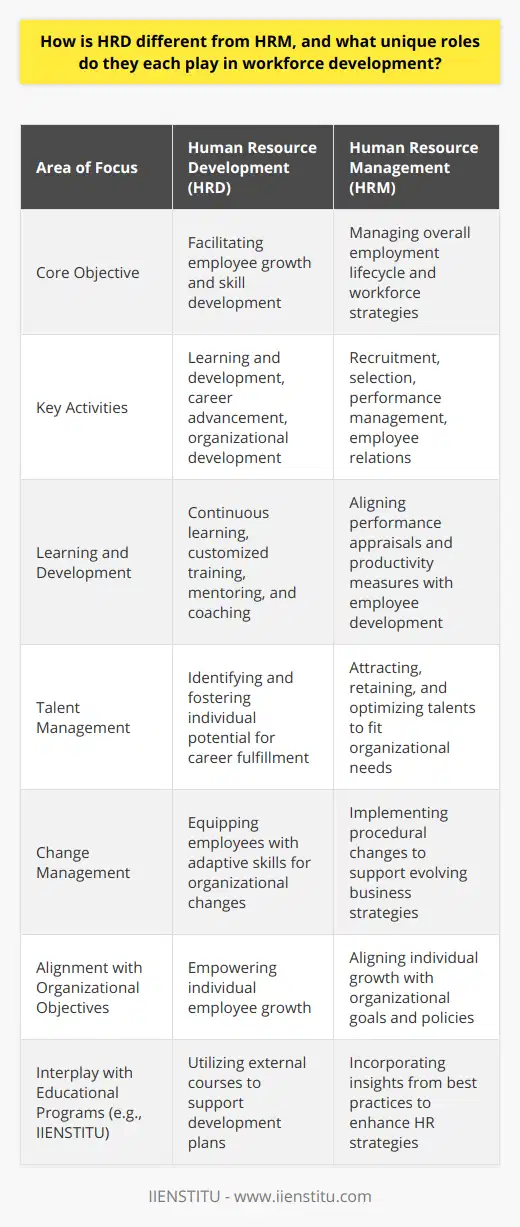
In the context of education and professional development, what does HRD stand for and how does it relate to leadership and management roles within an organization?
HRD: Human Resource Development
In the sphere of education and professional advancement, HRD stands for Human Resource Development. It refers to the system of deliberately enhancing and cultivating the skills, abilities, and expertise of a workforce to achieve organizational goals. HRD is directly involved in fostering a robust learning culture, ensuring the professional growth of employees, and promoting sustainable success in organizations.
Connection to Leadership and Management Roles
Leadership and management roles are intrinsically linked to HRD. Effective leaders and managers contribute significantly to an organization's overall growth by recognizing, developing, and retaining talent. These individuals are responsible for creating developmental opportunities, promoting a healthy learning environment, and providing necessary resources to facilitate the continuous development of their workforce.
Importance of HRD for Leaders and Managers
Having a strong grasp of HRD is essential for leaders and managers as it enables them to recognize the potential of their employees, helping them excel in their roles. By fostering a supportive and empowering workplace environment, leaders can ensure their employees are motivated, engaged, and can consistently deliver high-quality performance. Moreover, organizations that invest in HRD programs are better positioned to navigate challenges, drive innovation and maintain a competitive advantage in their respective markets.
Role of Leaders and Managers in HRD Implementation
Leaders and managers act as catalysts for the implementation of HRD policies and initiatives. They are entrusted with promoting a culture that encourages continuous learning and professional development. To achieve this, leaders and managers must actively engage with their employees, identify their strengths and shortcomings, and create tailored development plans that foster personal growth. Additionally, leaders should serve as mentors, provide constructive feedback, and encourage employees to take ownership of their development.
In conclusion, HRD plays a crucial role in the context of education and professional development. Understanding its relevance and application in leadership and management roles is essential for the sustainable growth of an organization. By promoting HRD, leaders and managers can inspire and develop top-performing employees, ensuring an organization's overall success.

What is HRD in the context of a business environment and how does it support organizational goals?
Understanding HRD in a Business Context
Human Resource Development (HRD) refers to the systematic process of enhancing the skills, knowledge, and competencies of employees within an organization. It encompasses a wide range of activities, such as training, education, and career development, which are aimed at improving individual and organizational performance.
Role of HRD in Supporting Organizational Goals
HRD plays a vital role in achieving organizational objectives by aligning individual employee capabilities with organizational needs. This alignment ensures maximum employee contribution to achieving the organization's strategic goals. Key ways through which HRD supports organizational goals include:
Strengthening Employee Skills: A central aspect of HRD is providing employees with training and development opportunities. This not only helps to improve the skills and knowledge required for their current roles, but also prepares them for future responsibilities within the organization. Enhanced employee skills ultimately lead to increased productivity and better quality work, contributing to overall organizational success.
Fostering Employee Engagement: HRD initiatives, such as career development programs and performance management systems, help to create an engaging work environment where employees feel valued, motivated, and committed to the organization's objectives. High levels of employee engagement result in increased retention, lower absenteeism, and a greater willingness to go the extra mile to achieve organizational goals.
Building a Strong Organizational Culture: HRD promotes a positive organizational culture by actively communicating company values and expectations, as well as providing employees with the tools and resources necessary to embody these values. A strong organizational culture is essential in enhancing employee commitment and driving overall business performance.
Encouraging Innovation: HRD fosters a culture of continuous learning and development, thereby encouraging employees to think creatively and come up with innovative solutions to organizational challenges. In a rapidly changing business environment, organizations that can adapt and innovate are better positioned to achieve long-term success.
Facilitating Change Management: HRD helps employees develop the necessary competencies to cope with, and effectively adapt to, changes in the business environment. By providing the required support and guidance, HRD ensures employees are equipped to handle transitions and contribute positively to the organization's transformation efforts.
In conclusion, Human Resource Development is an essential function within organizations, contributing to the achievement of organizational goals by developing skilled, engaged, innovative, and adaptable employees. It is a strategic investment that fosters growth, improves competitiveness, and ultimately leads to organizational success.
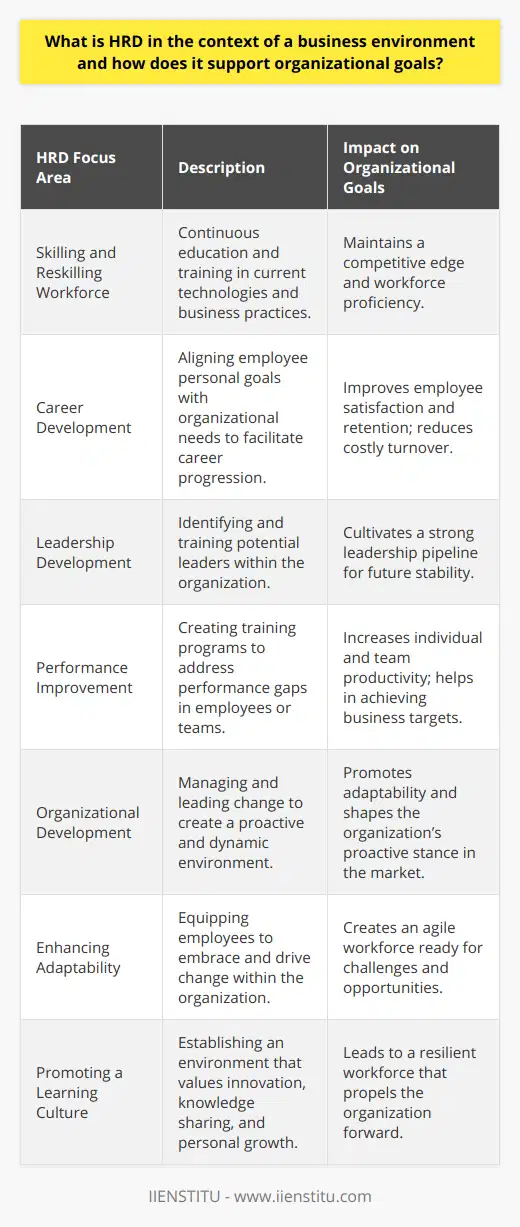
How is HRD influenced by technological advancements and global market trends?
Technological Impact on HRD
One primary way that technological advancements affect Human Resource Development (HRD) is through the automation of repetitive and routine tasks. The integration of technology enables HR professionals to perform their duties more efficiently and cost-effectively. For example, software tools aid HR professionals in managing payroll, benefits, and attendance more swiftly, allowing more focus on addressing strategic development needs.
Acceleration of Skill Development
Another way that technology influences HRD is through the upskilling of employees. As technological advancements rapidly permeate various industries, companies need to continuously invest in employee training and skill development to stay competitive in the global market. Online learning platforms provide personalized, trackable, and accessible training to employees, enabling companies to develop a skilled workforce capable of adapting to technological changes.
Transforming Recruiting and Onboarding
Technological advancements also shape the way HRD approaches recruiting and onboarding processes. The use of Artificial Intelligence (AI) and machine learning algorithms allows HR professionals to find the most suitable candidates more efficiently, as they analyze large sets of data in a shorter time than manual processes. Additionally, online platforms enable HR to conduct virtual interviews and onboarding sessions, facilitating a faster and more inclusive hiring process that spans geographical boundaries.
Change in the Work Culture
Technological advancements are creating a cultural shift in HRD by promoting remote work and flexible working hours. This change helps companies access talent from diverse geographical locations, which in turn contributes to an enriched workforce and improved retention rates. Furthermore, the inclusion of digital communication tools supports collaboration among remote teams, fostering a connected and transparent work environment.
Data-Driven Decision Making
Finally, technology empowers HRD to make more robust and informed decisions based on data-driven insights. Advanced analytical tools enable HR professionals to assess employee engagement and performance levels more accurately, identify specific areas for improvement, and develop tailored strategies for workforce development. This evidence-based approach to HRD ensures that organizations can respond more effectively to market trends, driving growth and success.
In conclusion, technological advancements and global market trends have a profound influence on HRD. By automating repetitive tasks, accelerating skill development, transforming recruitment and onboarding processes, changing work culture, and facilitating data-driven decision-making, technology is reshaping the landscape of HRD, making it more efficient, adaptable, and sustainable in today's competitive global market.
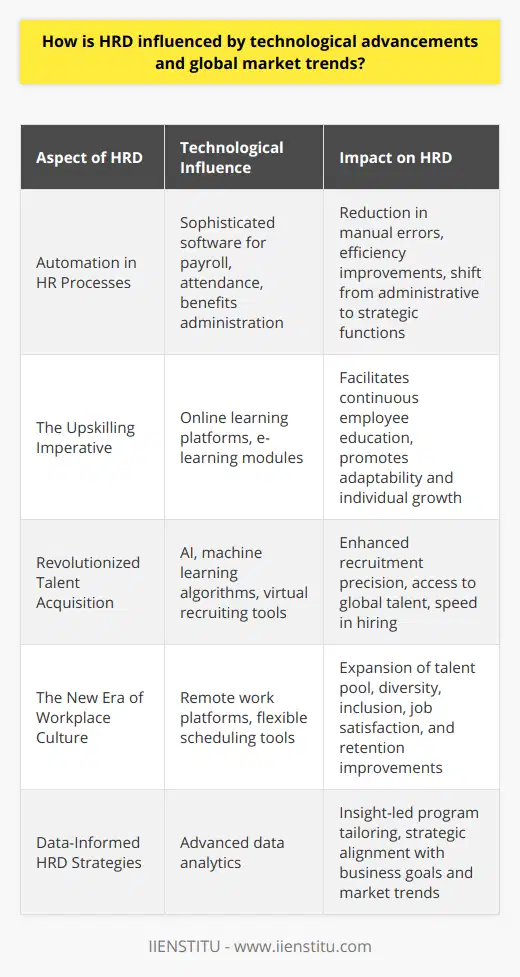
What role do HRD professionals play in enhancing employee engagement and job satisfaction?
Role of HRD Professionals in Employee Engagement
HRD (Human Resource Development) professionals play a pivotal role in enhancing employee engagement and job satisfaction. They design, implement, and evaluate various initiatives that cater to the holistic development of employees, fostering a positive work environment.
Creating a Supportive Work Culture
One of the responsibilities of HRD professionals is to establish a supportive work culture. They encourage open communication, provide feedback, and recognize employees' contributions, which leads to increased trust and motivation among the workforce.
Offering Career Development Opportunities
HRD professionals also ensure that employees are provided with ample career development opportunities. They conduct regular performance evaluation, identify career growth prospects, and facilitate trainings and workshops to ensure employees stay updated and skilled, thereby positively impacting job satisfaction.
Implementing Reward and Recognition Programs
A crucial aspect of employee engagement is the implementation of reward and recognition programs. HRD professionals design and execute these programs that acknowledge and appreciate employees for their achievements, instilling a sense of accomplishment and fostering loyalty and commitment.
Promoting Work-Life Balance
HRD professionals recognize the importance of work-life balance and implement initiatives that cater to employees' wellbeing. They advocate for flexible work hours, telecommuting, and employee wellness programs, contributing to higher job satisfaction and a motivated workforce.
Addressing Grievances and Conflict Resolution
By efficiently addressing employees' grievances and conflicts, HRD professionals ensure a harmonious work environment. They create a platform for employees to voice their concerns and take appropriate action to resolve any issues, resulting in increased job satisfaction and engagement.
Fostering Employee Collaboration and Team Building
HRD professionals place great importance on team building and collaboration, as they contribute to a sense of belonging and motivation in the workplace. They organize team-building activities and events that promote strong bonds among employees, leading to increased productivity and job satisfaction.
In conclusion, HRD professionals play a significant role in shaping a positive work environment where employees feel valued, supported, and motivated. By implementing comprehensive strategies, HRD professionals help organizations boost employee engagement and job satisfaction, ensuring increased productivity and a competitive edge in the market.
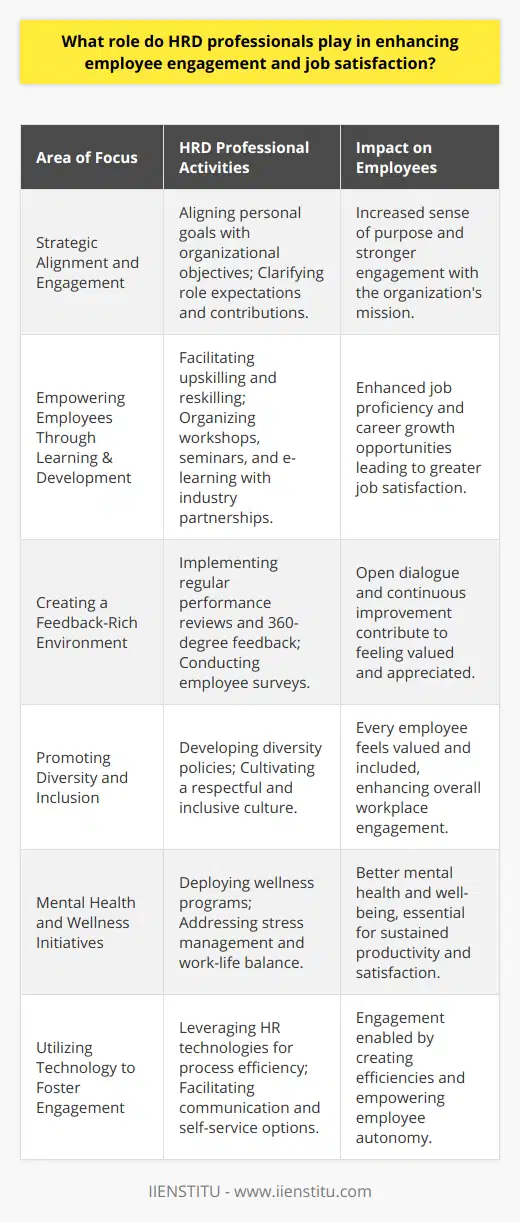
What is HRD also known as and how does it encompass various aspects of workforce development?
Introduction to HRD
Human Resource Development (HRD), also known as workforce development, refers to an integral aspect of strengthening an organization's human capital. HRD encompasses various aspects of workforce development, including employee training, career development, and organizational development. These components work together to ensure a high-performing and competent workforce.
Training and Development
Employee training and development is a key aspect of HRD, involving the enhancement of employees' skills and knowledge. This can be achieved through various methods, such as on-the-job training, e-learning, and classroom training. Offering targeted training programs to employees helps an organization to stay competitive by ensuring its workforce is equipped with advanced skills and competencies.
Career Development
HRD also focuses on supporting employees in their long-term career growth. Career development involves providing employees with opportunities for advancement, promotion, and further education. By investing in employees' careers, organizations build a skilled and motivated workforce, which contributes to overall organizational success.
Organizational Development
Another crucial aspect of HRD is organizational development, which aims to improve the effectiveness of an organization by aligning its culture, structure, and systems with its strategic goals. Various strategies, including change management, organizational design, and team-building, can be employed to foster a positive work environment that promotes productivity, creativity, and satisfaction among the workforce.
Conclusion
In conclusion, HRD, or workforce development, is a multifaceted approach to nurturing and developing an organization's human capital. By focusing on training and development, career development, and organizational development, HRD fosters a highly-skilled, motivated, and productive workforce that can drive organizational success and maintain its competitive edge in today's constantly evolving business landscape.
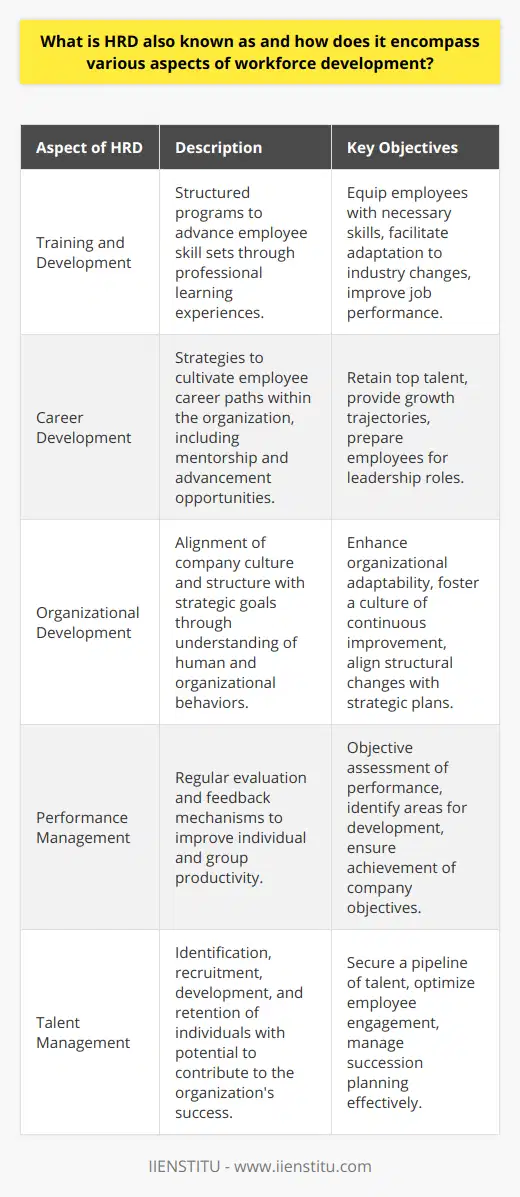
What is the focus of the HRD system and how is it instrumental in shaping an organization's talent management strategies?
Focus of HRD System
The Human Resource Development (HRD) system primarily focuses on enhancing the skills, knowledge, and competencies of employees within an organization. It emphasizes the continuous growth and development of the workforce through various interventions, including training, performance management, and succession planning. By investing in employee development, organizations can improve their overall performance and competitiveness in the market.
Role in Talent Management Strategies
HRD systems play an instrumental role in shaping an organization's talent management strategies. They enable organizations to identify potential talent within their workforce and develop them by providing relevant learning opportunities and career progression prospects. As a result, skilled and competent employees contribute effectively towards the achievement of organizational objectives.
Training and Development Initiatives
One crucial element of the HRD system is designing and implementing comprehensive training and development programs. These initiatives aim to equip employees with the necessary skills and knowledge to excel in their current roles and prepare for future challenges. By continuously improving employees' abilities, organizations can enhance productivity, adapt to changing business environments, and retain top talent.
Performance Management and Appraisal
Another aspect of the HRD system is the effective performance management and appraisal of employees. Regular evaluations of employee performance, through objective assessment processes, ensure that the organization's workforce remains aligned with its strategic goals. Consequently, organizations can identify key performers, provide relevant feedback, and plan reward and recognition strategies to motivate employees better.
Succession Planning
Lastly, the HRD system aids organizations in devising robust succession planning processes. Identifying potential leaders from within its ranks, it enables organizations to maintain continuity in leadership positions and mitigate the impacts of talent attrition. By grooming high-potential employees for future leadership roles, organizations can secure a reliable pipeline of skilled talent.
Conclusion
In summary, the focus of the HRD system lies in nurturing a workforce that is well-equipped to meet an organization's strategic objectives. Through efforts in employee training, performance management, and succession planning, HRD systems contribute significantly in shaping talent management strategies. Ultimately, a well-implemented HRD system can lead to a strong, competent workforce driving an organization's success.
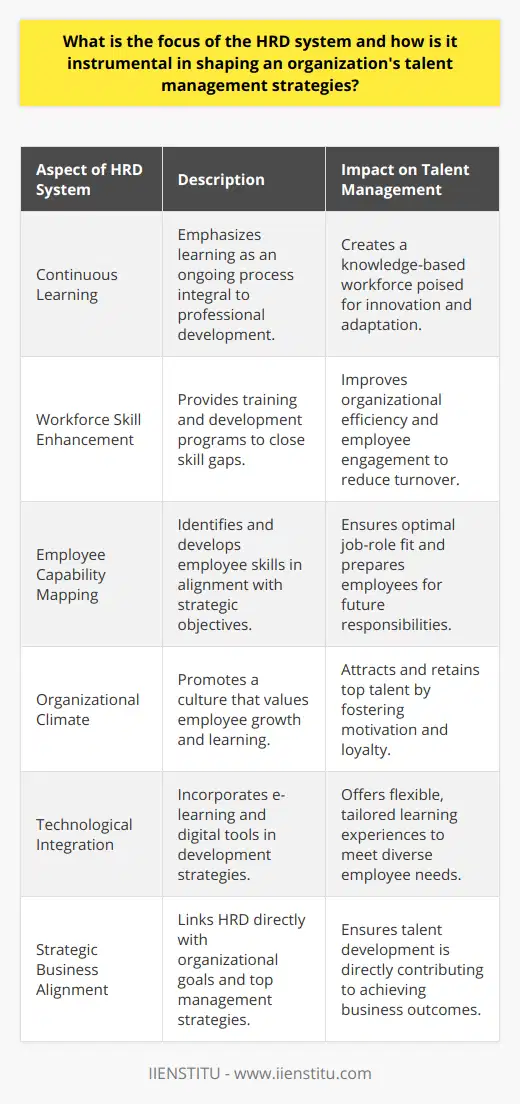
What is HRD in a business environment and how does it contribute to enhancing organizational capabilities and fostering innovation?
Understanding HRD
Human Resource Development (HRD) in a business environment refers to the practices adopted to improve organizational capabilities and strengthen employees' competencies. Key tasks of HRD include training and development initiatives, career planning, and performance management, all of which further the growth and progress of an organization.
Developing Organizational Capabilities
HRD plays a central role in enhancing organizational capabilities by focusing on employee skill-building and professional growth. By understanding the company's goals and delivering targeted training programs, HRD empowers employees to contribute effectively to the organization's objectives. Performance management, another core function of HRD, involves setting realistic performance expectations and evaluating employees' achievements, leading to higher productivity and morale.
Fostering Innovation
HRD contributes to fostering innovation in the workplace by creating a culture that encourages employees to think creatively and challenge established norms. This mindset enables employees to identify novel solutions to problems and discover new opportunities for the organization. HRD allows teams to be flexible and responsive, driving a culture of continuous improvement and innovation. In addition, emphasizing collaboration and cross-functional communication helps build diverse and creative perspectives, fueling idea generation and problem-solving.
Promoting Employee Engagement
The link between highly engaged employees and organizational success is well established. HRD nurtures a sense of ownership and commitment among employees by providing growth and progress opportunities for them. These programs, coupled with robust performance management systems, ensure employees remain motivated and engaged, directly positively impacting their contribution towards innovation.
Approach to Training and Development
An essential element of HRD is designing and delivering training programs that are both relevant and effective. Organizations must strike a balance between equipping employees with the skills required for the current job, while also preparing them for future roles and responsibilities. A customized approach to training helps address individual employee needs, allowing them to function more effectively and contribute towards the organization's innovation capabilities.
In conclusion, HRD is a vital function in a business environment, focusing on enhancing organizational capabilities and fostering innovation. By addressing employee growth, enabling a flexible and dynamic culture, and adopting targeted training and development programs, HRD can significantly impact an organization's progress and success.

What is HRD also known as, and how does it encompass various aspects of workforce development?
HRD Definition:
Human Resource Development (HRD), often known as workforce development, plays a critical role in the functionality of any organization. Essentially, it points to a framework focusing on the enhancement of employees' skills.
Goals of HRD:
Possessing many components, this involves nurturing individual development, boosting career growth, fostering a positive work culture, and enhancing leadership traits. Essentially, HRD aims to empower individuals with new skills, thereby offering the chance for career advancement.
Methods of HRD:
HRD does not stand by a rigid structure. Instead, it employs multiple strategies. These strategies may include training sessions, workshops, conferences, e-learning, and routine performance evaluations. Each of these methods targets a specific area of workforce development.
Impact of HRD:
The main purpose is to cultivate a highly skilled, efficient, and adaptable workforce. Through HRD, organizations can increase job satisfaction, improve employees' performance, and as a direct result, boost organizational productivity. This is because employees with enhanced skill sets perform their tasks better and are more likely to stay with the business.
Conclusion:
In the end, HRD or workforce development is instrumental to the lifespan and prosperity of any organization. Therefore, it should be a high priority for every business, regardless of its size or industry.
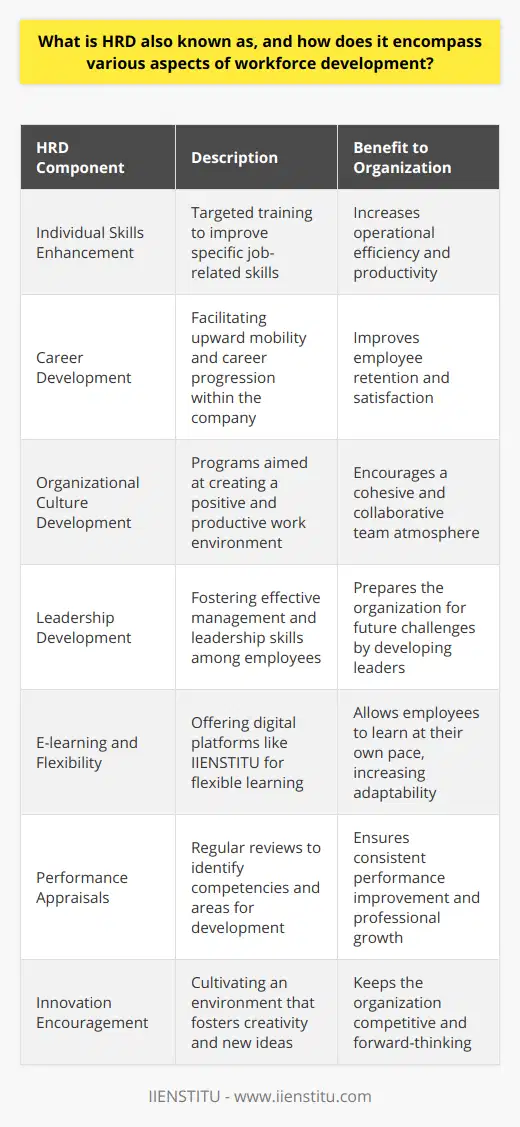
How is HRD influenced by technological advancements and global market trends?
Influence of Technological Advancements on HRD
Human Resource Development (HRD) has seen significant transformations due to technological advancements. E-learning, virtual training, and performance management systems have made pivotal changes. These digital tools provide new training modalities and employee development approaches, greatly enhancing HRD processes.
The Impact of Artificial Intelligence
Artificial intelligence (AI) has also greatly influenced HRD. AI allows for data-driven decision-making and predictive analytics in talent management. This results in increased efficiency and accuracy in recruitment, performance evaluations, and succession planning.
Global Market Trends Shaping HRD
Moreover, global market trends significantly impact HRD. The rise of the gig economy demands HRD strategies that accommodate remote workers, freelancers, and contract employees. This shift necessitates a reshaping of training and development programs to cater to these new workforce arrangements.
Influence of Globalization
Furthermore, globalization has intensified competition for top talent. HRD must therefore focus on strengthening employer branding and fostering employee engagement to attract and retain high-performing employees.
Effect of Sustainability Trends
Lastly, sustainability trends also direct the evolution of HRD. Organizations must develop employees' capabilities to drive sustainable business operations. Concurrently, HRD must also promote corporate social responsibility to attract socially conscious talents.
In conclusion, technological advancements and global market trends exert a profound influence on HRD. By adapting to these changes, organizations can better equip themselves for the future, ensuring successful talent management and organizational growth.

What role do HRD professionals play in enhancing employee engagement and job satisfaction?
Promoting Employee Engagement
HRD professionals play a vital role in enhancing employee engagement. They spearhead programs that promote a positive, interactive work environment. Their strategies, which may include team-building exercises, continuous feedback, and rewards or recognition, are key in facilitating interpersonal relationships and improving employee morale.
Improving Job Satisfaction
Job satisfaction stems from fulfilling and rewarding job experiences. HRD professionals contribute to this by providing employees with opportunities for growth and professional development. They also implement fair and competitive compensation packages, thus making the workplace more appealing to employees.
Employee Relationship Management
Moreover, HRD professionals manage the relationship between employees and the organization. They ensure open and effective communication channels that encourage employees to voice their concerns or suggestions. In doing so, they help foster a sense of belonging among employees, which can lead to higher job satisfaction.
Creating a Supportive Environment
A supportive work environment enhances employee engagement. HRD professionals work towards creating such an environment by promoting a nurturing and inclusive culture. They implement policies that provide work-life balance, ensure workplace safety, and promote mental well-being.
In conclusion, HRD professionals play a critical role in enhancing employee engagement and job satisfaction. Through strategic planning and consistent efforts, they create an enabling environment that motivates employees to perform at their best, thereby contributing to organizational success.

What is HRD also known as, and how does it encompass various aspects of workforce development?
Definition and Scope of HRD
HRD, an acronym for Human Resource Development, adopts a comprehensive approach towards developing an organization's workforce. Its focus is to enhance employee competencies, personal and career growth, which collectively contributes to business success.
Understanding HRD
To begin with, HRD relies on organized learning experiences. This dimension often includes professional training, skill enhancement, and knowledge-sharing initiatives. In practice, these activities augment employee performance, facilitating progress towards identified business goals.
HRD and Employee Education
Another key aspect of HRD is employee education. This sphere expands employee acumen and prowess over a wider range of subjects compared to their immediate work scopes. Through education programs, employees can gain a broader understanding of organizational functioning, leading to more informed decision-making and efficient problem-solving at work.
Investing in Employee Development
HRD also recognizes the potential benefits of personal growth and career advancement of employees. It facilitates this through opportunities for promotion, establishing clear career paths within organizations, and providing mentorship to emerging talent. The goal is to not only retain excellent employees but also to ensure their continuous growth within the organization.
Organizational Change and HRD
Lastly, HRD plays a crucial role in organizational change processes. This includes changes in strategy, technology, or culture where HRD helps in managing the transition. In essence, HRD becomes the bridge between the workforce and change, enabling smoother adjustments for employees.
In summary, HRD, or Human Resource Development, epitomizes the multi-faceted nature of workforce development. It encompasses various aspects, from organized learning experiences and employee education to personal growth and management of organizational change. Each prong of HRD contributes towards the holistic development of the workforce, thereby catalyzing business success.

How is HRD different from HRM, and what unique roles do they each play in workforce development?
Distinct Differences
Human Resource Development (HRD) and Human Resource Management (HRM) serve different but complementary roles within organizations. HRM involves designing and implementing HR policies, systems, and procedures for managing human resources effectively. It covers various functional areas such as recruitment, training, performance management, payroll, and benefits administration. On the other hand, HRD focuses on providing employees with learning and development opportunities to enhance their skills, capabilities, and productivity.
Roles in HRM
HRM plays a critical role in workforce development by attracting and retaining talented employees. Effective HRM practices help to select the right people for the right jobs and retain them by ensuring their satisfaction and well-being. HRM also maintains a robust performance management system to assess and improve employees' performance and productivity.
Roles in HRD
The role of HRD, meanwhile, is primarily to foster a learning culture within the organization. It ensures that employees continuously improve their skills and competencies to meet current and future business needs. HRD initiatives include organizing training programs, facilitating coaching and mentoring, promoting knowledge sharing, and supporting career development.
Inter-Relationship
The inter-relationship between HRM and HRD is vital for workforce development. While HRM is responsible for managing the workforce, HRD ensures that the workforce is continuously improving and adapting to evolving business requirements. Together, HRM and HRD enhance the quality of the workforce, drive employee engagement and motivation, and consequently contribute to organizational success.

What is HRD in a business environment and how does it contribute to enhancing organizational capabilities and fostering innovation?
Understanding HRD in Business
HRD refers to Human Resource Development in a business environment. It comprises effective training programmes, growth opportunities, and strategies for enhancing employees' knowledge, skills, and abilities. This approach is a pivotal part of management strategies, focused on elevating employee competencies, which in return improves organizational productivity.
Contributions to Organizational Capabilities
HRD plays a significant role in enhancing organizational capabilities. Through learning programs, employees gain knowledge, learn about innovative tools and techniques, and improve operational efficiency. Consequently, it leads to improved productivity and profits. With employees learning tailored skills, businesses can enjoy consistent growth and success. In fact, HRD invigorates operational flexibility, allowing organizations to adapt swiftly to fast-paced market changes.
Promoting Innovation
Besides, HRD fosters innovation in a business environment. It promotes a culture of learning and idea exchange, sparking creativity among employees. This culture does not just encourage novel ideas, but it also drives their implementation. Innovation, largely fueled by HRD, helps organizations to create unique solutions for existing problems and craft cutting-edge products or services, providing them with a competitive edge in the market.
In summary, HRD in a business environment is a potent tool that drives employee development, enhances organizational capabilities, and fosters innovation. It's an investment in human capital that pays off in increased productivity, greater adaptability, and a stronger competitive position in the rapidly changing business landscape.
